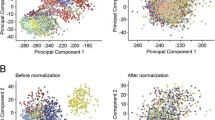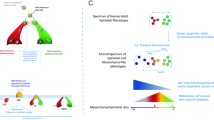Abstract
There is increasing support for the hypothesis that most tumors contain a subpopulation of cells, referred to here as tumor initiating cells (TICs), with the ability to self-renew and to regenerate all the cell types within the tumor. TICs are enriched in breast cancer patients after common treatments, indicating their intrinsic therapeutic resistance. Two independently-derived gene transcription “signatures” of TICs from different studies indicate enrichment of TICs within the recently-identified “claudin-low” intrinsic molecular subtype of breast cancer. These are characterized by high expression of markers associated with epithelial-mesenchymal transition (EMT), suggesting that claudin-low cells may arise from more immature stem or progenitor cells than other breast cancers. EMT is a process by which cells acquire molecular alterations that facilitate dysfunctional cell–cell adhesive interactions and junctions, as well as a more spindle-shaped morphology. These processes may promote cancer cell progression and invasion into the surrounding microenvironment. Induction of EMT in immortalized human mammary epithelial cells results in an increased ability to form mammospheres, and in the expression of stem cell and TIC markers, suggesting that there may be a direct link between the EMT and the gain of TIC properties. Targeting specific molecular pathways—such as Notch, Wnt, and TGFß—associated with development and EMT in the TIC subpopulation, in addition to conventional chemo- and radiation therapies that target the bulk tumor, may ultimately provide a more effective strategy in treating breast cancer. Here, we review recent evidence of the involvement of EMT in breast cancer TICs, focusing on clinical studies.



Similar content being viewed by others
Abbreviations
- EMT:
-
Epithelial-mesenchymal transition
- TIC:
-
Tumor-initiating cells
References
Vargo-Gogola T, Rosen J. Modelling breast cancer: one size does not fit all. Nat Rev Cancer. 2007;7:659–72.
Sorlie T, Perou CM, Tibshirani R, Aas T, Geisler S, Johnsen H, et al. Gene expression patterns of breast carcinomas distinguish tumor subclasses with clinical implications. Proc Natl Acad Sci U S A. 2001;98(19):10869–74.
Visvader J, Lindeman G. Cancer stem cells in solid tumours: accumulating evidence and unresolved questions. Nat Rev Cancer. 2008;8:755–68.
Al-Hajj M, Wicha M, Benito-Hernandez A, Morrison S, Clarke M. Prospective identification of tumorigenic breast cancer cells. Proc Natl Acad Sci U S A. 2003;100:3983–8.
Li X, Lewis M, Huang J, Gutierrez C, Osborne C, Wu M, et al. Intrinsic resistance of tumorigenic breast cancer cells to chemotherapy. J Natl Cancer Inst. 2008;100(9):672–9.
Creighton C, Li X, Landis M, Dixon J, Neumeister V, Sjolund A, et al. Residual breast cancers after conventional therapy display mesenchymal as well as tumor-initiating features. Proc Natl Acad Sci U S A. 2009;106(33):13820–5.
Bonnet D, Dick J. Human acute myeloid leukemia is organized as a hierarchy that originates from a primitive hematopoetic cell. Nat Med. 1997;3:730–7.
Ricci-Vitiani L, Lombardi D, Pilozzi E, Biffoni M, Todaro M, Peschle C, et al. Identification and expansion of human colon-cancer-initiating cells. Nature. 2007;445:111–5.
Singh S, Hawkins C, Clarke I, Squire J, Bayani J, Hide T, et al. Identification of human brain tumour initiating cells. Nature. 2004;432:396–401.
Dontu G, Abdallah W, JM F, Jackson K, Clarke M, Kawamura M, et al. In vitro propagation and transcriptional profiling of human mammary stem/progenitor cells. Genes Dev. 2003;17(10):1253–70.
Dontu G, Jackson K, McNicholas E, Kawamura M, Abdallah W, Wicha M. Role of Notch signaling in cell-fate determination of human mammary stem/progenitor cells. Breast Cancer Res. 2004;6(6):R605–15.
Dontu G, Al-Hajj M, Abdallah W, Clarke M, Wicha M. Stem cells in normal breast development and breast cancer. Cell Prolif. 2003;36(suppl_1):59–72.
Bao S, Wu Q, McLendon R, Hao Y, Shi Q, Hjelmeland A, et al. Glioma stem cells promote radioresistance by preferential activation of the DNA damage response. Nature. 2006;444:756–60.
Liu G, Yuan X, Zeng Z, Tunici P, Ng H, Abdulkadir I, et al. Analysis of gene expression and chemoresistance of CD133+ cancer stem cells in glioblastoma. Mol Cancer. 2006;5:67.
Jones R, Matsui W, Smith B. Cancer stem cells: are we missing the target? J Natl Cancer Inst. 2004;96(8):583–5.
Sorlie T, Tibshirani R, Parker J, Hastie T, Marron JS, Nobel A, et al. Repeated observation of breast tumor subtypes in independent gene expression data sets. Proc Natl Acad Sci U S A. 2003;100(14):8418–23.
Herschkowitz J, Simin K, Weigman V, Mikaelian I, Usary J, Hu Z, et al. Identification of conserved gene expression features between murine mammary carcinoma models and human breast tumors. Genome Biol. 2007;8:R76.16.
Hennessy B, Gonzalez-Angulo A, Stemke-Hale K, Gilcrease M, Krishnamurthy S, Lee J, et al. Characterization of a naturally occurring breast cancer subset enriched in epithelial-to-mesenchymal transition and stem cell characteristics. Cancer Res. 2009;69(10):4116–24.
Liu R, Wang X, Chen G, Dalerba P, Gurney A, Hoey T, et al. The prognostic role of a gene signature from tumorigenic breast-cancer cells. N Engl J Med. 2007;356:217–26.
Shipitsin M, Campbell L, Argani P, Weremowicz S, Bloushtain-Qimron N, Yao J, et al. Molecular definition of breast tumor heterogeneity. Cancer Cell. 2007;11(3):259–73.
van de Vijver MJ, He YD, Van’t Veer LJ, Dai H, Hart AA, Voskuil DW, et al. A gene-expression signature as a predictor of survival in breast cancer. N Engl J Med. 2002;347:1999–2009.
Sorlie T, Tibshirani R, Parker J, Hastie T, Marron JS, Nobel A, et al. Repeated observation of breast tumor subtypes in independent gene expression data sets. Proc Natl Acad Sci U S A. 2003;100(14):8418–23.
Lim E, Vaillant F, Wu D, Forrest N, Pal B, Hart A, et al. Aberrant luminal progenitors as the candidate target population for basal tumor development in BRCA1 mutation carriers. Nat Med. 2009;15(8):907–13.
Guarino M, Rubino B, Ballabio G. The role of epithelial-mesenchymal transition in cancer pathology. Pathology. 2007;39:305–18.
Damonte P, Gregg J, Borowsky A, Keister B, Cardiff R. EMT tumorigenesis in the mouse mammary gland. Lab Invest. 2007;87:1218–26.
Kokkinos M, Wafai R, Wong M, Newgreen D, Thompson E, Waltham M. Vimentin and epithelial-mesenchymal transition in human breast cancer—observations in vitro and in vivo. Cells Tissues Organs. 2007;185:191–203.
Lee J, Dedhar S, Kalluri R, Thompson E. The epithelial-mesenchymal transition: new insights in signaling, development, and disease. J Cell Biol. 2006;172:973–81.
Sarrio D, Rodriguez-Pinilla S, Hardisson D, Cano A, Moreno-Bueno G, Palacios J. Epithelial-mesenchymal transition in breast cancer relates to the basal-like phenotype. Cancer Res. 2008;68:989–97.
Trimboli A, Fukino K, de Bruin A, Wei G, Shen L, Tanner S, et al. Direct evidence for epithelial-mesenchymal transitions in breast cancer. Cancer Res. 2008;68:937–45.
Ma L, Teruya-Feldstein J, Weinberg RA. Tumour invasion and metastasis initiated by microRNA-10b in breast cancer. Nature. 2007;449(7163):682–8.
Sarrio D, Rodriguez-Pinilla SM, Hardisson D, Cano A, Moreno-Bueno G, Palacios J. Epithelial-mesenchymal transition in breast cancer relates to the basal-like phenotype. Cancer Res. 2008;68(4):989–97.
Trimboli AJ, Fukino K, de Bruin A, Wei G, Shen L, Tanner SM, et al. Direct evidence for epithelial-mesenchymal transitions in breast cancer. Cancer Res. 2008;68(3):937–45.
Shimono Y, Zabala M, Cho R, Lobo N, Dalerba P, Qian D, et al. Downregulation of miRNA-200c links breast cancer stem cells with normal stem cells. Cell. 2009;138(3):592–603.
Gregory P, Bracken C, Bert A, Goodall G. MicroRNAs as regulators of epithelial-mesenchymal transition. Cell Cycle. 2008;7(20):3112–8.
Wellner U, Schubert J, Burk U, Schmalhofer O, Zhu F, Sonntag A, et al. The EMT-activator ZEB1 promotes tumorigenicity by repressing stemness-inhibiting microRNAs. Nat Cell Biol. 2009;11(12):1487–95.
Iliopoulos D, Polytarchou C, Hatziapostolou M, Kottakis F, Maroulakou I, Struhl K, et al. MicroRNAs differentially regulated by Akt isoforms control EMT and stem cell renewal in cancer cells. Sci Signal. 2009;2(92):ra62.
Mani S, Guo W, Liao M, Eaton E, Ayyanan A, Zhou A, et al. The epithelial-mesenchymal transition generates cells with properties of stem cells. Cell. 2008;133(4):704–15.
Mani SA, Yang J, Brooks M, Schwaninger G, Zhou A, Miura N, et al. Mesenchyme Forkhead 1 (FOXC2) plays a key role in metastasis and is associated with aggressive basal-like breast cancers. Proc Natl Acad Sci U S A. 2007;104(24):10069–74.
Gupta P, Onder T, Jiang G, Tao K, Kuperwasser C, Weinberg R, et al. Identification of selective inhibitors of cancer stem cells by high-throughput screening. Cell. 2009;138(4):645–59.
Huber M, Kraut N, Beug H. Molecular requirements for epithelial-mesenchymal transition during tumor progression. Curr Opin Cell Biol. 2005;17(5):548–58.
Dontu G, El-Ashry D, Wicha MS. Breast cancer, stem/progenitor cells and the estrogen receptor. Trends Endocrinol Metab. 2004;15(5):193–7.
Dontu G, Jackson KW, McNicholas E, Kawamura MJ, Abdallah WM, Wicha MS. Role of Notch signaling in cell-fate determination of human mammary stem/progenitor cells. Breast Cancer Res. 2004;6(6):R605–15.
Dontu G, Liu S, Wicha MS. Stem cells in mammary development and carcinogenesis: implications for prevention and treatment. Stem Cell Rev. 2005;1(3):207–13.
Dontu G, Wicha MS. Survival of mammary stem cells in suspension culture: implications for stem cell biology and neoplasia. J Mammary Gland Biol Neoplasia. 2005;10(1):75–86.
Liu S, Dontu G, Wicha MS. Mammary stem cells, self-renewal pathways, and carcinogenesis. Breast Cancer Res. 2005;7(3):86–95.
Liu S, Ginestier C, Charafe-Jauffret E, Foco H, Kleer CG, Merajver SD, et al. BRCA1 regulates human mammary stem/progenitor cell fate. Proc Natl Acad Sci U S A. 2008;105(5):1680–5.
Korkaya H, Paulson A, Iovino F, Wicha M. HER2 regulates the mammary stem/progenitor cell population driving tumorigenesis and invasion. Oncogene. 2008;27(47):6120–30.
Acknowledgements
Grant Support: This study was supported in part by the Breast Cancer Research Foundation (JCC), the Helis Foundation (JCC, JMR), the NCI Breast Cancer SPORE P50 CA50183 (JCC, CJC), 1 R01 CA112305-01 from the National Cancer Institute (JCC), P30 CA125123 from the National Institute of Health (JCC, CJC), grant-in-aid from Glaxo Smith Kline (JCC), and US Army Medical Research and Materiel Command DAMD17-01-0132 and W81XWH-04-1-0468 (JCC).
Author information
Authors and Affiliations
Corresponding author
Rights and permissions
About this article
Cite this article
Creighton, C.J., Chang, J.C. & Rosen, J.M. Epithelial-Mesenchymal Transition (EMT) in Tumor-Initiating Cells and Its Clinical Implications in Breast Cancer. J Mammary Gland Biol Neoplasia 15, 253–260 (2010). https://doi.org/10.1007/s10911-010-9173-1
Received:
Accepted:
Published:
Issue Date:
DOI: https://doi.org/10.1007/s10911-010-9173-1




